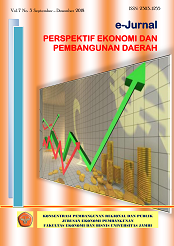Pengaruh pertumbuhan ekonomi, rata-rata lama sekolah dan tingkat pengangguran terhadap tingkat kemiskinan di Provinsi Jambi
DOI:
https://doi.org/10.22437/pdpd.v10i1.12493Abstract
This study aims to: 1) To analyze the conditions of economic growth, the average length of schooling, unemployment rate, the poverty rate in Jambi Province 2001-2018. 2) To analyze the effects of economic growth, the average length of schooling, and the unemployment rate on poverty levels in Jambi Province in the period 2001-2018. The research analysis tool uses multiple linear regression analysis tools. Based on the results of the simultaneous test that economic growth, the average length of schooling, and unemployment rate together have a significant effect on poverty levels in Jambi Province, while the partial test results say that the significant effect on poverty levels is the variable of economic growth and the average length of the school. Then the results of the determination test indicate that the level of poverty is influenced by the independent variables in this study that is equal to 60.7 percent.
Keywords: Economic growth, Average length of school, Unemployment rate, Poverty rate
Downloads
References
A Delis, C Mustika, E Umiyati. (2015).Pengaruh FDI terhadap kemiskinan dan pengangguran di Indonesia 1993-2013, Jurnal Paradigma Ekonomika, 10 (1)
Ariefianto, Moch. Doddy, (2011). Ekonometrika: esensi dan aplikasi dengan menggunakan eviews. Erlangga: Jakarta
Arsyad, Lincolin. (2007). Ekonomi pembangunan. UPP STIM YKPN : Yogyakarta
Badan Pusat Statistik. (2008). Analisis dan perhitungan tingkat kemiskinan. Jakarta
Boediono, (1999). Teori pertumbuhan ekonomi, seri Sinopsis, Edisi Pertama, Cetakan Pertama BPFE: Yogyakarta.
Gujarati, Damodar H. (2003). Basic econometrics. McGraw-Hill, Inc: Singapura
Haughton, J., dan Khandker, Shahidur R. (2012). Handbook on poverty and inequality (pedoman tentang kemiskinan dan ketimpangan) Terj. Salemba Empat: Jakarta
Haughton, Jonathan dan Khandker, Shahidur R. 2012. Pedoman Tentang Kemiskinan dan Ketimpangan. Salemba Empat. Jakarta.
Junaidi, J. & Zulfanetti, Z. (2016). Analisis Kondisi dan Proyeksi Ketenagakerjaan di Provinsi Jambi. Jurnal Perspektif Pembiayaan dan Pembangunan Daerah 3 (3), 141-150
Lanjouw, P., M. Pradhan, F. Saadah, H. Sayed, R. Sparrow, (2001). Poverty, education and health in Indonesia: who benefits from public spending? World Bank Working Paper No. 2739. World Bank: Washington.
PH Prihanto, A Bhakti. (2017). Profile of informal sector workers and factors affecting informal sector employment in Jambi Province, Jurnal Perspektif Pembiayaan dan Pembangunan Daerah, 5 (2), 63-70
Sukirno, Sadono. (2004). Makro ekonomi, teori pengantar. Rajawali Press: Jakarta.
Susiati, M (2013). Pendidikan dan kemiskinan, Erlangga: Jakarta
Winarno. (2011). Analisis ekonometrika dan statistika dengan eviews, edisi ketiga. Unit UPP STIM YKPN: Yogyakarta
World Bank. (2006). Making the new Indonesia work for the poor.
Downloads
Published
How to Cite
Issue
Section
License
Copyright (c) 2021 Nandita Putri Syabrina, Hardiani Hardiani, Candra Mustika

This work is licensed under a Creative Commons Attribution 4.0 International License.





